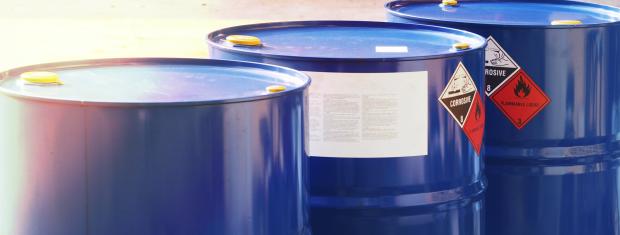
Combustibles 101: How to Store, Handle and Use Gasoline and Diesel Fuel Safely
Every year, hundreds and thousands of fires are intensified by combustible materials. A combustible material is one of which will ignite and burn or will add appreciable heat to an ambient fire.
While materials such as wood and paper are indeed combustibles, liquid combustibles such as gasoline and diesel fluid are those that contribute to some of the most devastating losses as they carry explosive properties.
Flammable & Combustible Liquids Container
Certified safety cans are the best choice for storing small quantities of flammable or combustible materials such as gasoline or diesel fuel. These containers have a variety of safety features that plastic gas cans or other unapproved containers such as glass jars do not, such as:
- Sturdy Base
- Tight-fitting, self-closing lids
- Flash arrestor screen
- Automatic pressure vents
These containers come in color-coded varieties to identify gasoline, diesel and kerosene. Labeling the containers by their contents adds an additional layer of protection.
Flammable liquids should never be stored inside of a home, especially in the basement. Flammable liquid vapors are heavier than air and will accumulate at ground or floor level. Water heaters, furnaces, clothes dryers, and other types of appliances could easily ignite the vapors which could escape from a storage container. If more than 25 gallons of flammable or combustible liquids are used, then the containers should be stored in a flammable liquids storage cabinet (even if safety cans are used).
Always fill the container on the ground. Never fill the container on the back of a pickup truck with a plastic or carpet bed liner. Static electricity can build up and a discharge of this build-up can result in a spark that could ignite the vapors and result in a fire or explosion.
Before you refill the container, touch the dispenser nozzle to the container to dissipate any static charge. Ensure part of the nozzle remains in contact with the container inlet throughout the entire refilling process. Never refuel equipment while it’s hot, and absolutely never smoke during refueling.
Aboveground Storage Tanks
Aboveground storage tanks for diesel fuel and gasoline must be located at least 40 feet from any building. A tank designed for aboveground use should never be used as underground tanks. The tank should rest on level, firm ground or on surfaces made of masonry, concrete, steel or piling. These tanks must be designed and built in accordance with recognized engineering standards for the material of construction being used. The minimum separation distance from a gasoline storage tank to an LP gas container must be 20 feet.
Tank supports must be designed and constructed in accordance with recognized engineering standards – made of concrete, masonry or steel protected against corrosion. They should be designed to resist damage as a result of shocks, such as an earthquake. Additionally, aboveground tanks should be protected from motor vehicles by use of collision barriers.
Ensure the outdoor storage space is protected from tampering and/or trespassers. The area surrounding such tanks should remain free from weeds, trash and other unnecessary combustibles. Mark the tank based on its contents and the nature of the fire hazard, placing “No Smoking” signs in the vicinity.
Single-wall storage tanks should be equipped with a diking system to prevent accidental spills. A diking system can be constructed from earth, steel, concrete, or solid masonry. The system must be liquid-tight. Ensure the draining water from diked areas is controlled to prevent liquids from entering natural water courses, public sewers, or public drains.
Underground Storage Tanks
Storage tanks housed underground should remain a minimum distance of 1 foot from building foundations and 3 feet from property lines. Underground tanks should never be used aboveground.
The piping of underground tanks needs to be protected against corrosion by either a cathodic protection system or by use of approved or listed corrosion-resistant materials or systems.
Underground tanks require venting systems that provide sufficient capacity to prevent blowback of vapor or liquid at the fill opening while the tank is being filled. This piping should never be less than 1.25 inches inside diameter and it should extend 12 feet above grade level to vent vapors away from sources of ignition. Vent outlets shall be located a minimum of 5 feet from any building opening to prevent flammable vapors from finding a source of ignition inside the building.


